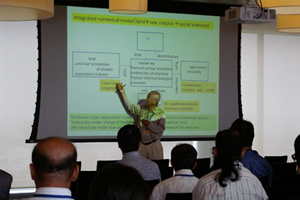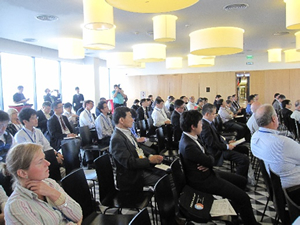Oct 11, 2016
Report of ICM and Satoumi Special Session
- Date
- August 23, 2016
- Place
- Azimut Hotel(Saint Petersburg, Russian Federation)
Overview of ICM and Satoumi Special Session

At the 11th International Conference on the Environmental Management of Enclosed Coastal Sea (EMECS 11), ICM (the Integrated Coastal Management) and Satoumi Special Session was held following the Opening Ceremony, and was attended by approximately 70 persons.
Following the opening remarks by Vice Governor Kanazawa of Hyogo Prefecture , the special session began with the convener of the session, Professor Tetsuo Yanagi of the International EMECS Center, explaining that the purpose of the session was firstly to report the interim progress of the research currently being conducted in Japan under the Environmental Research and Technology Development Fund S-13 “Development of Coastal Management Method to Realize the Sustainable Coastal Sea,” and secondly to conduct a comparison study of ICM with various relevant countries and establish more effective ICM.

The first half of the special session dealt with the S-13 fund. Professor Yanagi of the International EMECS Center gave an overall explanation of S-13 and reported on the major achievements to date. Next, Dr. Tetsuji Okuda of Ryukoku University gave a presentation relating to Topic 1 (Development of methods for managing nutrients concentrations in the Seto Inland Sea) “Fate of silts and clay from river and its contribution to transparency.”
Next, Dr. Teruhisa Komatsu of the Atmosphere and Ocean Research Institute, The University of Tokyo, gave a presentation on Topic 2 (Development of coastal environmental management methods on the Sanriku Coast, which has a succession of open inner bays) “The decline in the number of oyster rafts has contributed to the shortening of the cultivation period and an improvement in bottom layer dissolved oxygen concentration in summer.”
Following this, Dr. Takafumi Yoshida of the Northwest Pacific Region Environmental Cooperation Center, gave a presentation relating to Topic 3 (Development of methods for ocean management in the Japan Sea, an international enclosed coastal sea that includes continental shelves and islands) “Three-level management at the international, domestic and local levels is effective.”
Finally, Professor Kenichi Nakagami of Ritsumeikan University gave a presentation relating to Topic 4 (Proposed economic assessment and integrated coastal management model for ecosystem services in coastal seas) “The economic value of the Seto Inland Sea has been increasing in recent years.”
These four presentations sparked a discussion between the audience and the presenters that included questions from the audience such as “How are social science achievements incorporated into integrated numerical models?” and “What determines the economic value of the environment?”
The second half of the session dealt with issues relating to ICM around the world. To start with, Mr. Keizo Negi from the Office for Environmental Management of Enclosed Coastal Seas, Ministry of the Environment, Japan gave a presentation on “Measures for water environmental management.” He was followed by Professor Robert Michael Summers, University of Maryland, U. S. A., with a presentation “Sustainable restoration and protection of coastal waters: the Chesapeake Bay Total Maximum Daily Load Plan.” Next, Professor David A. Nemazie of the same university gave a presentation entitled “Developing an Environmental Health Report Card for Laguna de Bay, Philippines.” This was followed by Dr. Suhendar I. Sachoemar from the Agency for the Assessment and Application of Technology, Indonesia, who gave a presentation entitled “Implementation of sustainable aquaculture as a model of Sato Umi to improve productivity within coastal area of Indonesia.” Lastly, Dr. Ruben Kosyan of the P. P. Shirshov Institute of Oceanology, Russia spoke on “Development of the basic criteria for Russian coasts typification.”
The presentations were followed by a spirited discussion that featured questions such as “What are the differences between Japan and the United States in terms of policies to reduce total pollutant load?”, “How can we get companies to cooperate in reducing total pollutant load?”, “Are there any differences between the health check for the oceans in Japan and that in the Philippines?”, “How are the items for the ocean health check determined?”, “How is the frequency with which ocean health checks are conducted determined?” and “What measures can be taken for ocean garbage containing microplastics?” All this confirmed the need to continue to hold sessions relating to ICM and Satoumi at future conferences.

